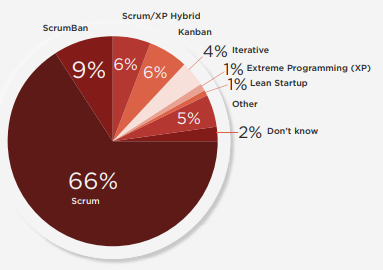Scrum is by far the most popular framework these days. In fact, the 15th Annual State of Agile shows that 66% of respondees use this particular framework.

What this survey does not show, is what my experience does show: the implicit expectation that frameworks will solve your issues. I hate having to break it to you: they don’t.
It starts with a burning platform
The most recurring reason for familiarity with Scrum that I’ve seen is that someone saw it on LinkedIn or heard some nice buzzwords that appealed to management, and all of the sudden the entire organization is all-in.
The thing with that is that such an approach lacks its ‘why’. Why are we going to change? What is the added benefit? Ideally, you start to focus on the issues you and your organization are facing. Three easy questions to ask in that context:
- Is there an issue that we’re facing?
- What are the potential consequences of that issue?
- What options do we have to mitigate that?
Or to quote the popular Liberating Structure:
- What?
- So what?
- Now what?
Out of all the potential solutions, Scrum is just one of them. And even if that option is the one you’re gonna go for, change is still needed in order to progress.
This also implies not slapping the same framework across the entire organization blindly. I’ve seen large organizations yell out “you’re all going to do SAFe from now on!” And they literally meant everyone. That skips over the fact that a hypothetical issue A, with its accompanying people and micro-culture, potentially requires a vastly different approach than issue B. So many variables get ignored by using the same blanket to spread across the entire organization.
“If you want to change, you have to start with yourself”
An annoyingly true quote from my therapist. I was discussing this with students in my latest PSM class as well. There are two dominant aspects being overlooked most often during the implementation of Scrum.
1. If you want to succeed with Scrum, plot the organization to Scrum instead of the other way around
What continuously comes back during those classes, and in many consulting gigs, is that Scrum is mapped over the existing teams and organizations. This doesn’t say anything about whether you have the right skills in the teams to deliver Done Increments on a consistent basis (the true meaning of cross-functionality).
Forget about departments and silos. Think about what you need to change, whether that’s mindset, behavior, or structure, in order to maximize potential. Yes, that’s probably gonna be tough and painful at times. But as many famous philosophers scream during hard-fought battles in the Iron Temple “No Pain, No Gain!”.

Captions added by yours truly
2. The customer couldn’t care less about what framework you adopt
As long as you get the job done. Have you ever wondered if your car manufacturer used the latest molding machine? Or if your local bar has the best insulation to keep the beer cold? No, right? And that’s no different for your clients either. They don’t care if you use Scrum, LeSS, SAFe, or anything else. And even if you’d use LeSS, they’d still want more.
Just get the job done. That’s all they care about.
And adding to that, perfect execution of a framework does not guarantee value whatsoever. As much as I love Scrum, and its community, perfect execution does not equal a solution by default. Or to quote Mr. Liston in the Savannah Georgian, 1829:
“The operation was successful, but the patient died!”
Scrum is a means to an end. Not the end itself. Ultimately it boils down to delivering value. And for that, you need to constantly evolve.
Don’t treat Scrum as your salvation
Scrum could work wonders. But it could just as well do nothing and makes things more painful. I’m convinced, though, that many organizations that operate in the complex domain and require adaptive solutions, could benefit from a lightweight framework like Scrum.

Photo by Claudio Schwarz on Unsplash
To sum this article up, however, just the implementation of a framework is not going to magically solve your issues. There is no silver bullet, no one-size-fits-all approach. It requires courage and tough decisions to make the needed changes in behavior, organizational structure, and ways of delivery to sorting the desired effect.
Also, remember that Scrum is a means to an end and not the end itself. Customers care about the end, not how you get there. Perfect Scrum is not something your user cares about — they just want to get their needs met.
What’s the biggest change that you would make in your organization if nothing would stop you?
Join the Mastering Agility Discord community
